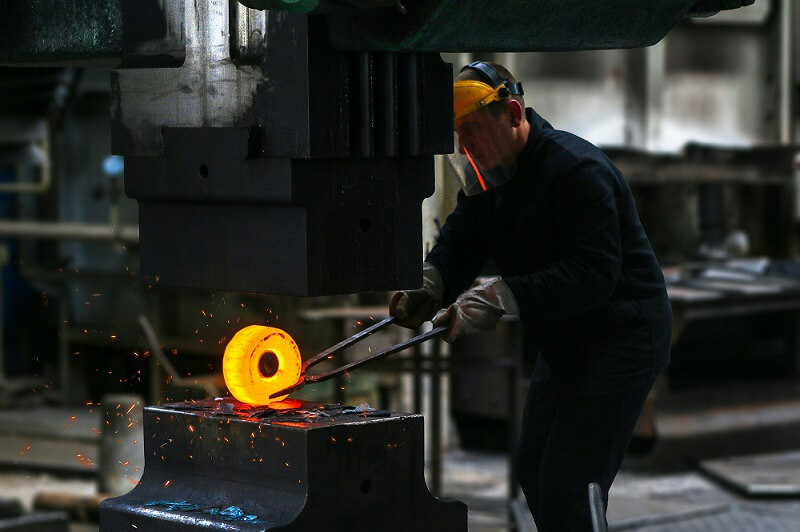The fundamental components of glass melting furnaces and kilns are refractory materials, which have a significant impact on glass quality, energy consumption, and manufacturing costs. The advancement of refractory production technology and the improvement of refractory product quality will have an impact on the future of glass melting technology.
- Refractory fire clay brick: Fire clay bricks are composed mainly of Al2O3. The Al2O3 content is between 30 and 45%; density ranges from 1.7 and 2.4G/cm3; apparent porosity ranges from 11 to 22%; the most working temperature is 1350 to 1520°C. In glass manufacturing, fire clay bricks are generally suitable for regions such as the base of the furnace, the working poll’s sidewall and its lateral wall, the crown, and the regenerator’s lower layers, and the fire chimney. The volume of fire clay bricks will likewise increase if the temperature rises. The volume will decrease again when the temperature exceeds 1450°C.
- Silica Bricks: Silicon dioxide is the major component of silica brick (SiO2). The glass melting furnace requires a silica brick with a SiO2 content of at least 94 percent, a maximum working temperature of roughly 1600-1650°C, and a density of around 1.81.95g/cm3. The apparent porosity of the material must be less than 22%. The lower the apparent porosity, the lower the grade of silica brick. In the glass melting furnace, it’s mostly used for the crown and breast walls.
- Refractory High Alumina Bricks: Al2O3 is likewise the main component of refractory high alumina bricks, however, the content of Al2O3 should be higher than 46 percent, often between 46 and 80 percent. High alumina bricks have a density of 2.553.0g/cm3, an apparent porosity of 18%–24%, and a maximum operating temperature of 1500°–1650°C. Corrosion resistance is better when the apparent porosity of the high alumina brick is low. For the sidewall of the cooling cool, the regenerator crown, and the regenerator walls, high-alumina bricks can be utilized.
- Fused Cast AZS Bricks: The proportion of ZrO2 in fused cast AZS (Alumina Zirconia Silica) bricks (electro-fused zirconia corundum bricks) is commonly split into three types: 33 percent, 36 percent, and 41 percent. The zirconia corundum bricks used in the glass furnace application have a 50 percent Al2O3 content and a 20 percent ZrO2 content. The bulk density is 3.44.0g/cm3, the apparent porosity is 1%–10%, and the maximum use temperature is approximately 1700°C. Fused cast AZS bricks with 33 percent and 36 percent ZrO2 content are typically used for melter side walls, breast walls, pavement blocks, ports, and tongues, among other applications.
- Refractory Insulation Bricks: In order to save energy and reduce consumption, a significant volume of insulation materials is necessary for comprehensive heat preservation in the glass melting furnace when the heat dissipation region and the thermal efficiency are low. To reduce heat dissipation, the regenerator, melter, working end, and other components must be insulated on the sidewall, bottom, crown, and walls. Insulation brick has a high apparent porosity, a lightweight, and a bulk density of less than 1.3g/cm3. The thermal insulation brick with a wide apparent porosity has a thermal insulation effect because the heat transfer performance of air is very poor. Because its heat conductivity is 2 to 3 times that of common refractory materials, the higher the apparent porosity, the better the insulation effect. Insulation bricks come in a variety of shapes and sizes, including fire clay insulation bricks, silicon insulation bricks, and high alumina thermal insulation bricks, among others.
- Refractory Mullite Bricks: Mullite refractory bricks are mostly composed of Al2O3, with an Al2O3 content of roughly 75%. Because it is primarily mullite crystal, so it refers to as mullite brick. The density ranges from 2.2 to 3.2g/cm3, the apparent porosity ranges from 1% to 12%, and the maximum operating temperature ranges from 1500 to 1700 degrees Celsius. The sidewalls of regenerators are mostly made of sintered mullite. Fused mullite is commonly used on the sidewalls of cooling towers, observation holes, and wall stacks, among other things.
- Refractory Alkaline Materials: Magnesia bricks, aluminium magnesia bricks, magnesia chrome bricks, and forsterite bricks are commonly used alkaline refractory materials. Its refractoriness ranges from 1900 to 2000 degrees Celsius, and it has exceptional corrosion resistance to alkaline compounds. It’s common in the upper wall of the glass melting furnace’s regenerator, the regenerator wall, the regenerator checker, and the port’s partial structure.
- Fused Corundum Bricks: It refers majorly to refractory fused-cast corundum bricks, having mostly 92% ~ 94% Al2O3 corundum crystal phase, its volume density is 2.9 ~ 3.0g/cm3, and their apparent porosity lies between 1% ~ 10% & the highest operating temperature is about 1700°C. Fused alumina has a high resistance to glass dialysis and pollutes molten glass very little. It’s commonly used for sidewalls of working polls, bottom pavings, forehearths, throats, and feeder walls in glass melting furnaces, among other things, that are connected with liquid glass and do not require liquid contamination.
- Quartz bricks: Quartz bricks consist predominantly of SiO2, with a maximum concentration of more than 99%, a 1.9 ~ 2g/cm3 density, a 1650°C refractoriness, work temperatures of around 1600°C, and corrosion resistance to acidic matter. It is used for building the acid boron glass pool wall. Thermocouple flame spacing bricks hole, etc.
Conclusion
The glass melting furnaces are industrial installations within which complex and interconnected physical and chemical phenomena occur. To improve the functioning and quality of the produced glass, the relationship between heat transfers and flows into the melted glass, the interaction of heat transfers and the thermal control of the furnace, the relationship of heat transfers to the quality of the glass, and heat transfer between molten glass, the furnace walls, etc. must be studied.
Refractory manufacturers in India are constantly working in Research & Development to provide the best quality refractory products for Glass manufacturing Industry.
